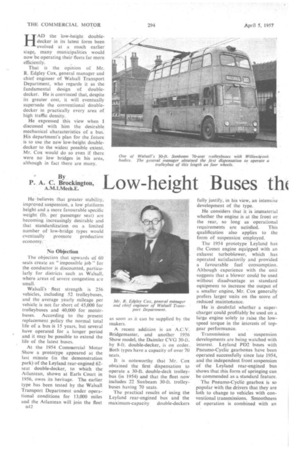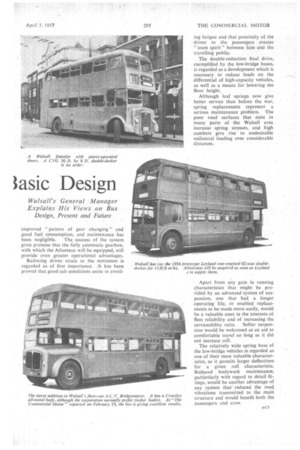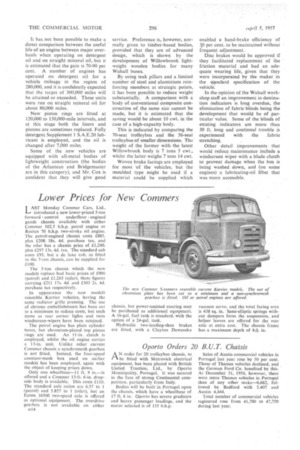Low-height Buses th(
Page 52

Page 53

Page 54

If you've noticed an error in this article please click here to report it so we can fix it.
asic Design
Walsall's General Manager Explains His Views an Bus Design, Present and Future By P. A. C. Brockington,
A.M.I.Mech.E. HAD the low-height doubledecker in its latest form been evolved at a much earlier stage, many municipalities would now be operating their fleets far more efficiently.
7
That is the opinion of Mr. R. Edgley Cox, general manager and chief engineer of Walsall Transport Department, who regards it as the fundamental design of doubledecker. He is convinced that despite its greater cost, it will eventually supersede the conventional doubledecker in practically every area of high traffic density.
He expressed this view when I discussed with him the desirable mechanical characteristics of a bus. His department's plan for the future is to use the new low-height doubledecker to the widest possible extent. Mr. Cox would do so even if there Were no low bridges in his area, although in fact there are many.
He believes that greater stability, improved suspension, a low platform height and a more favourable specific weight. (lb. per passenger seat) are becoming increasingly desirable and that standardization on a limited number of low-bridge types would eventually promote production economy: No Objection The objection that upwards of 60 seats create an "impossible job " for the conductor is discounted, particularly for districts such as Walsall, where areas of severe congestion are small.
Walsall's fleet strength is 256 vehicles, including 52 trolleybuses, and the average yearly mileage per vehicle is not far short of 45,000 for trolleybuses and 4-0,000 for mottirbuses. According to the present replacement policy the normal total life of a bus is 15 years, but several have operated for a longer period and it may be possible to extend the life of the latest buses.
At the 1954 Commercial Motor Show a prototype appeared at the last minute (in the demonstration park) of the Leyland rear-engined 62seat double-decker, to which the Atlantean, shown at Earls Court in 1956, owes its heritage. The earlier type has been tested by the Walsall Transport Department under operational conditions for 13.000 miles and the Atlantean will join the fleet D12 as soon as it can be supplied by the makers.
A recent addition is an A.C.V. Bridgemaster, and another 1956 Show model, the Daimler CVG 30-ft. by 8-ft. double-decker, is on order. Both types have a capacity of over 70 seats, It is noteworthy that Mr. Cox obtained the first dispensation to operate a. 30-ft. double-deck trolleybus (in 1954) and that the fleet now includes 22 Sunbeam 30-ft. trolleybuses having 70 seats.
The practical results of using the Leyland rear-engined bus and the maximum-capacity double-deckers fully justify, in his view, an intensive development of the type.
He considers that it is immaterial whether the engine is at the front or the rear, so long as operational requirements are satisfied. This qualification also applies to the form of suspension employed.
The 1954 prototype Leyland has the Comet engine equipped with an exhaust turboblower, which has operated. satisfactorily and provided a favourable fuel consumption. Although experience with the unit suggests that a blower could be used without disadvantage as standard equipment to increase the output of a smaller engine, Mr.. Cox generally prefers larger units on the score of reduced maintenance.
He is doubtful whether a supercharger could profitably be used on a large engine solely to raise the lowspeed torque in the interests of topgear performance.
Transmission and suspension developments are being watched with interest. Leyland PD2 buses with Pneumo-Cyclic gearboxes have been operated successfully since late 1954, and the independent front suspension of the Leyland rear-engined bus shows that this form of springing can be commended as a standard feature.
The Pneumo-Cyclic gearbox is so popular with the drivers that they are loth to change to vehicles with conventional transmissions. Smoothness of operation is combined with an improved "pattern of gear changing" and good fuel consumption, and maintenance has been negligible. The, success of the system gives promise that the fully automatic gearbox, with which the Atlantean will be equipped, will provide even greater operational advantages.
Reducing driver strain to the minimum is regarded as of first importance. ", It has been proved that good cab conditions assist in avoid ing fatigue and that proximity of the driver to the passengers creates "team spirit" between him and the travelling public.
The double-reduction final drive, exemplified by the low-bridge buses, is regarded as a development which is necessary to reduce loads on the differential of high-capacity vehicles, as well as a means for lowering the floor height.
Although leaf springs now give better service than before the war, spring replacements represent a serious maintenance problem. The poor road surfaces that exist in many parts of the. Walsall area increase spring stresses, and high cambers give rise to undesirable unilateral loading over considerable distances.
Apart from any gain in running characteristics that might be provided by an advanced system of suspension, one that had a longer operating life, or enabled replacements to be made more easily, would be a valuable asset in the interests of fleet reliability and of increasing the serviceability ratio. Softer suspension would be welcomed as an aid to comfortable travel so long as it did not increase roll.
The relatively wide spring base of the low-bridge vehicles is regarded as one of their most valuable character. istics, as it permits larger deflections for a given roll characteristic. Reduced bodywork maintenance, particularly with regard to detail fittings, would be another advantage of any system that reduced the road vibrations transmitted to the main structure and would benefit both the passengers and crew.
It has not been possible to make a direct comparison between the useful life of an engine between major overhauls when operating on detergent oil and on straight mineral oil, but it is estimated that the gain is 70-90 per cent. A number of engines has operated on detergent oil for a vehicle mileage in the region of 280,000, and it is confidently expected that the target of 300,000 miles will he attained or exceeded. These units were run on straight mineral oil for about 80,000 miles.
New piston rings are fitted at 120,000 to 150,000-mile intervals, and at this stage both the liners and pistons are sometimes replaced. Fully detergent Supplement 1 S.A.E,20 lubricant is employed, and the oil is changed after 7,000 miles.
Some of the new vehicles are equipped with all-metal bodies of lightweight construction (the bodies of the Atlantean and Bridgemaster are in this category), and Mr. Cox is confident that they will give good service. Preference is, however, normally given to timber-based bodies, provided that they are of advanced design. which is shown by the development of Willowbrook lightweight wooden bodies for many Walsall buses.
By using teak pillars and a limited number of steel and aluminium reinforcing members at strategic points, it has been possible to reduce weight substantially. A comparison with a body of conventional composite construction of the same size cannot be made, but it is estimated that the saving would be about 10 cwt. in the case of a high-capacity body.
This is indicated by comparing the 70-seat trolleybus and the 56-seat trolleybus of smaller dimensions. The weight of the former with the latest Willowbrook body is 7 tons 5 cwt., whilst the latter weighs 7 tons 14 cwt.
Woven brake facings are employed for most of the vehicles, but the moulded type might be used if a material could be supplied which enabled a hand-brake efficiency of 10 per cent, to be maintained without frequent adjustment.
Disc brakes would be approved if they facilitated replacement of the friction material and had an adequate wearing life, given that they were incorporated by the maker in the standard specification of the vehicle.
In the opinion of the Walsall workshop staff an improvement in destination indicators is long overdue, the elimination of fabric blinds being the development that would be of particular value. Some of the blinds of existing indicators are more than 30 ft. long and continual trouble is experienced with the fabric stretching.
Other detail improvements that would reduce maintenance include a windscreen wiper with a blade clutch to prevent damage when the bus is being washed down, and (on some engines) a lubricating-oil filter that was -more accessible.
















































































































